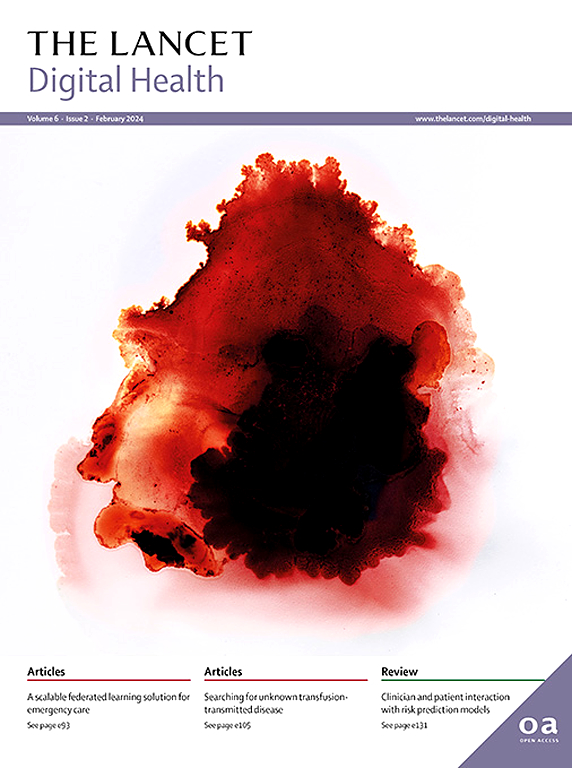通过应用于视网膜图像的深度学习进行糖尿病肾病的无创活检诊断:一项基于人群的研究。
IF 23.8
1区 医学
Q1 MEDICAL INFORMATICS
引用次数: 0
摘要
背景:提高筛查糖尿病肾病(DKD)的可及性和鉴别孤立性糖尿病肾病与非糖尿病肾病(NDKD)是糖尿病护理领域的两大挑战。我们的目标是开发和验证一个人工智能(AI)深度学习系统,以检测DKD并从视网膜眼底图像中分离糖尿病肾病。方法:在这项基于人群的研究中,我们开发了一个基于视网膜图像的人工智能深度学习系统DeepDKD,使用734 084张视网膜眼底图像进行预训练。首先,对于DKD检测,我们使用了来自上海糖尿病综合预防和护理系统1212578名参与者的486 312张视网膜图像进行开发和内部验证,并使用了来自中国、新加坡、马来西亚、澳大利亚和英国的10个多民族数据集(65406名参与者)进行外部验证。其次,为了区分孤立性糖尿病肾病和NDKD,我们使用来自267名参与者的1068张视网膜图像进行开发和内部验证,并使用来自中国、马来西亚和英国的3个多民族数据集(244名参与者)进行外部验证。最后,我们进行了两项概念验证研究:一项为期3个月的前瞻性现实研究,以评估DeepDKD筛查DKD的有效性;并通过4·6年随访,对DeepDKD鉴别孤立性糖尿病肾病与NDKD对肾功能变化的影响进行纵向分析。结果:对于检测DKD, DeepDKD在内部验证数据集上的受试者工作特征曲线下面积(AUC)为0.842 (95% CI为0.838 ~ 0.846),在外部验证数据集上的AUC为0.791 ~ 0.826。为了区分孤立性糖尿病肾病和NDKD, DeepDKD在内部验证数据集上的AUC为0.906(0.825 - 0.966),在外部验证数据集上的AUC为0.733 - 0.844。在前瞻性研究中,与元数据模型相比,DeepDKD检测DKD的灵敏度更高(89.8% vs 66.3%)。解释:在不同的多民族糖尿病人群中,基于视网膜图像的ai深度学习系统在临床实践中显示出检测DKD和区分孤立性糖尿病肾病与NDKD的潜力。资助:国家重点研发计划、国家自然科学基金、北京市自然科学基金、上海市临床重点专科、上海市内分泌与代谢疾病研究中心、上海市地方高水平高校创新研究团队、非传染性慢性病国家科技重大专项、上海市卫生健康委员会临床专项、《上海市加强公共卫生体系建设三年行动计划》。本文章由计算机程序翻译,如有差异,请以英文原文为准。
Non-invasive biopsy diagnosis of diabetic kidney disease via deep learning applied to retinal images: a population-based study
Background
Improving the accessibility of screening diabetic kidney disease (DKD) and differentiating isolated diabetic nephropathy from non-diabetic kidney disease (NDKD) are two major challenges in the field of diabetes care. We aimed to develop and validate an artificial intelligence (AI) deep learning system to detect DKD and isolated diabetic nephropathy from retinal fundus images.
Methods
In this population-based study, we developed a retinal image-based AI-deep learning system, DeepDKD, pretrained using 734 084 retinal fundus images. First, for DKD detection, we used 486 312 retinal images from 121 578 participants in the Shanghai Integrated Diabetes Prevention and Care System for development and internal validation, and ten multi-ethnic datasets from China, Singapore, Malaysia, Australia, and the UK (65 406 participants) for external validation. Second, to differentiate isolated diabetic nephropathy from NDKD, we used 1068 retinal images from 267 participants for development and internal validation, and three multi-ethnic datasets from China, Malaysia, and the UK (244 participants) for external validation. Finally, we conducted two proof-of-concept studies: a prospective real-world study with 3 months' follow-up to evaluate the effectiveness of DeepDKD in screening DKD; and a longitudinal analysis of the effectiveness of DeepDKD in differentiating isolated diabetic nephropathy from NDKD on renal function changes with 4·6 years' follow-up.
Findings
For detecting DKD, DeepDKD achieved an area under the receiver operating characteristic curve (AUC) of 0·842 (95% CI 0·838–0·846) on the internal validation dataset and AUCs of 0·791–0·826 across external validation datasets. For differentiating isolated diabetic nephropathy from NDKD, DeepDKD achieved an AUC of 0·906 (0·825–0·966) on the internal validation dataset and AUCs of 0·733–0·844 across external validation datasets. In the prospective study, compared with the metadata model, DeepDKD could detect DKD with higher sensitivity (89·8% vs 66·3%, p<0·0001). In the longitudinal study, participants with isolated diabetic nephropathy and participants with NDKD identified by DeepDKD had a significant difference in renal function outcomes (proportion of estimated glomerular filtration rate decline: 27·45% vs 52·56%, p=0·0010).
Interpretation
Among diverse multi-ethnic populations with diabetes, a retinal image-based AI-deep learning system showed its potential for detecting DKD and differentiating isolated diabetic nephropathy from NDKD in clinical practice.
Funding
National Key R & D Program of China, National Natural Science Foundation of China, Beijing Natural Science Foundation, Shanghai Municipal Key Clinical Specialty, Shanghai Research Centre for Endocrine and Metabolic Diseases, Innovative research team of high-level local universities in Shanghai, Noncommunicable Chronic Diseases-National Science and Technology Major Project, Clinical Special Program of Shanghai Municipal Health Commission, and the three-year action plan to strengthen the construction of public health system in Shanghai.
求助全文
通过发布文献求助,成功后即可免费获取论文全文。
去求助
来源期刊

Lancet Digital Health
Multiple-
CiteScore
41.20
自引率
1.60%
发文量
232
审稿时长
13 weeks
期刊介绍:
The Lancet Digital Health publishes important, innovative, and practice-changing research on any topic connected with digital technology in clinical medicine, public health, and global health.
The journal’s open access content crosses subject boundaries, building bridges between health professionals and researchers.By bringing together the most important advances in this multidisciplinary field,The Lancet Digital Health is the most prominent publishing venue in digital health.
We publish a range of content types including Articles,Review, Comment, and Correspondence, contributing to promoting digital technologies in health practice worldwide.
 求助内容:
求助内容: 应助结果提醒方式:
应助结果提醒方式:


